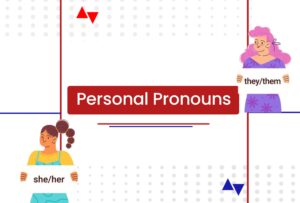Est. reading time: 5 minutes

Personal pronouns are fundamental elements of the English language that replace nouns in sentences to avoid repetition and add clarity. They typically refer to people, animals, or objects; they vary based on their function in a sentence.
In this article, I will give full details of what personal pronouns are, their types, and common mistakes to avoid when using them.
What are personal pronouns?
These are pronouns that replace nouns and are used to refer to people, animals, or things in a way that shows the first person (the person speaking), the second person (the person spoken to), and the third person (the person or thing being spoken about).
Pronouns are known to replace nouns, and just like every other pronoun, personal pronouns are used in place of names of a person, animals, place or things.
What are first, second, and third-person Pronouns?
While the term ‘person’ can be used to describe a human, it is often used in English grammar to explain situations. In this case, for instance, it is a grammatical way of classifying pronouns into different parts.
Earlier in the article we gave a brief insight into what first, second, and third personal pronouns are. We will be doing a further explanation about each of these pronouns.
First Person Pronoun
A first-person pronoun is a pronoun that refers to the speaker or writer themselves. It includes:
Singular: I (subject), me (object)
Plural: we (subject), us (object)
Second Person Pronoun
A second person pronoun refers to the person or people being spoken to or addressed and they are commonly used in both writing and speech. They include:
Singular: you (subject and object)
Plural: you (subject and object)
Third Person Pronoun
Third-person pronouns refer to individuals or things other than the speaker (first person) or the listener (second person). They can be used to refer to someone or something that is being talked about or mentioned in conversation or writing.
These pronouns can be singular (e.g., he, she, it) or plural (e.g., they), and they vary based on gender and number.
Third-person pronouns can be used when you as a speaker or writer want to refer to individuals or objects without constantly repeating their names.
Types of Personal Pronouns
Personal pronouns can vary in form based on number (typically singular or plural), case, gender, or formality, and can refer to objects, animals, or people.
Here are the types of personal pronouns:
Singular and Plural Personal Pronouns
Before we go fully into what singular and plural personal pronouns are, it is important to know the examples.
To help with that, we will make a list of them; I, you, me, he, she, her, him, it, we, us, and them.
Furthermore, it is important to be able to identify the singular personal pronouns from the plural. We will do a breakdown of this in the table below:
| Singular
(Subject) |
Plural
(Subject) |
Singular
(Object) |
Plural
(Object) |
|
| First Person | I | We | Me | Us |
| Second Person | You | You | You | You |
| Third Person | He/She/It | They | Him/Her/It | Them |
For a better understanding of the table above, we will discuss what subject and object personal pronouns mean as we move on.
Subject and Object Personal Pronouns
In the case where a personal pronoun takes the place of a noun as the subject of a sentence, it is referred to as both a personal pronoun and a subject pronoun.
Here are the Subject personal pronouns in the English language: I, You, We, He, She, It, and They.
For Example: She loves reading books.
‘She’ in this sentence is the personal pronoun and at the same time a subject personal pronoun.
On the other hand, object personal pronouns differ from subject personal pronouns but are equally important, with the object personal pronouns being: Me, You, Him, Her, It, Us, and Them.
For Example: The teacher praised him for his intelligence
From the example above, we can easily tell the function that the personal pronoun in that sentence is performing. The personal pronoun in the sentence is ‘him’ and it acts as the object of the sentence.
Possessive Personal Pronouns
Talk of personal pronouns that show ownership or possession, then you have the possessive personal pronouns.
Possessive personal pronouns are used in place of using a noun followed by an apostrophe and an ‘s’ (‘s). For instance instead of saying, “The book is Hannah’s,” you can say “The book is hers”.
Here are examples:
Singular:
- Mine (first person)
- Yours (second person)
- His (third person masculine)
- Hers (third person feminine)
- It (third person neuter)
Plural:
- Ours (first person)
- Yours (second person)
- Theirs (third person)
Let’s see more examples:
- The book is mine. (Indicating ownership by the speaker.)
- Is this pen yours? (Asking about ownership by the listener.)
- The cat licked its plate. (Showing possession by an animal.)
- The house is theirs. (Indicating ownership by multiple individuals.)
Reflexive Personal Pronouns
Reflexive personal pronouns are pronouns that refer back to the subject of the sentence. They are used when the subject and the object of the verb are the same entity. Reflexive pronouns always end with the word ‘-self’ (singular) or ‘-selves’ (plural).
To emphasize the subject’s role in the action or to indicate that the subject performed the action on itself, reflexive pronouns are used. They are not necessary for the sentence’s meaning but add emphasis or clarity.
Here are the reflexive pronouns in English:
Singular:
- Myself (first person)
- Yourself (second person)
- Himself (third person masculine)
- Herself (third person feminine)
- Itself (third person neuter)
Plural:
- Ourselves (first person)
- Yourselves (second person)
- Themselves (third person)
Examples of reflexive personal pronouns in sentences:
- I hurt myself while cooking.
- She talks to herself when she’s nervous.
- They decorated the room themselves.
Common Mistakes With Personal Pronouns in the English Language
It is very important to know how to use personal pronouns in sentences to avoid errors in writing and speaking.
Here are common personal pronoun mistakes in the English language:
Confusion between ‘its’ and ‘it’s’
‘Its’ is a possessive pronoun, while ‘it’s’ is a contraction of ‘it is’ or ‘it has’. For example, let’s compare the two sentences “The cat licked its paw” (possessive) and “It’s raining outside” (contraction).
Misuse of ‘me’ and ‘I’
‘Me’ is an object pronoun used as the object of a verb or preposition, while ‘I’ is a subject pronoun used as the subject of a sentence or clause.
For example, “He gave the book to me” (object) versus ‘I gave the book to him” (subject).
So you can’t say, “he gave the book to I” as ‘I’ usually acts as the subject in a sentence and not the object.
Using ‘their’ with singular nouns
‘Their’ is a plural possessive pronoun, so it should only be used with plural nouns. Using it with singular nouns is grammatically incorrect.
For example, ‘Each student brought their lunch’ should be ‘Each student brought his or her lunch’ or ‘Each student brought their lunches.’
Incorrect use of reflexive pronouns:
Reflexive pronouns should only be used when the subject and object refer to the same entity. Incorrect use includes phrases like, “He did it to myself” instead of “He did it to himself”.
Conclusion
In conclusion, personal pronouns are essential in English as they replace nouns to avoid repetition and enhance clarity. By recognizing and avoiding common mistakes, you can use personal pronouns correctly, thereby improving your writing and speaking skills.

